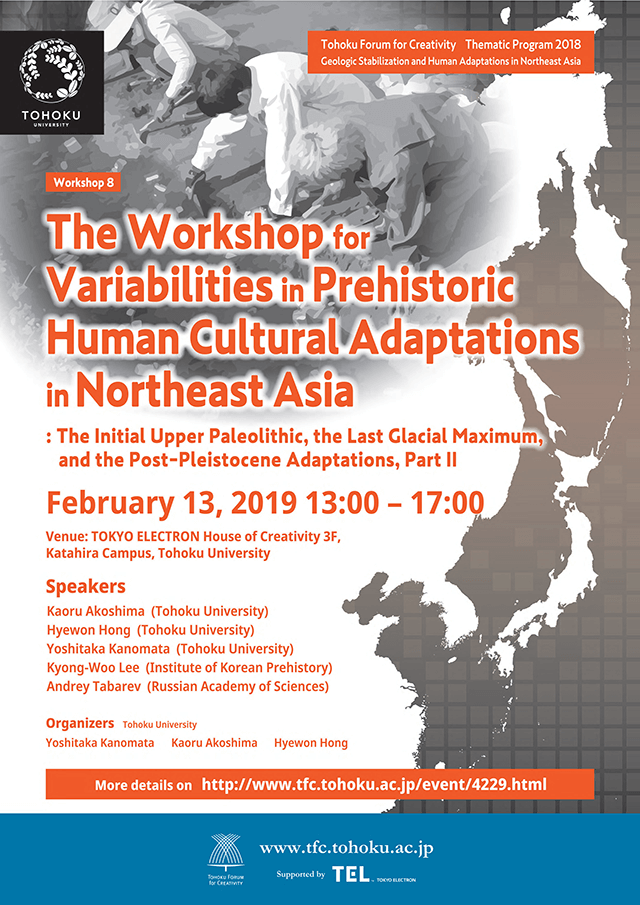The Workshop for Variabilities in Prehistoric Human Cultural Adaptations in Northeast Asia: The Initial Upper Paleolithic, the Last Glacial Maximum, and the Post–Pleistocene Adaptations, PartⅡ
Information
The workshop is actually the second part of the international symposium held in August 4–5, 2018 at Tohoku University,
Tohoku Forum for Creativity. The part 2 invites Korean and Russian specialists
to further investigate the research topics described below.
Expansion of modern humans into the arctic landscape during prehistoric times was the complicated processes of interaction
between fluctuating environments and diversity in cultural measures of adaptation.
The workshop aims to shed light on the territorial expansion of prehistoric populations throughout Northeast Asia,
their variabilities in subsistence and technology, and successes and failures in exploitations of natural resources
such as game animals, plant crops, and specific geological rock types
in the landscape as raw materials for tools in highly mobile settlement patterns.
The interdisciplinary program entails specialists in the Far Eastern Paleolithic archaeology,
microscopic stone tool analysis, geological landscape, and diachronic environmental reconstructions.
The focus of discussion centers on critical time periods when the strict environments of the arctic placed selection pressures
onto human populations with cultural means of adaptations. The Initial Upper Paleolithic (ca.40,000 to 35,000 BP)
was the period of transition from the discoidal core based industries toward more efficient blade based industries.
Human group mobility increased and selection of certain high quality lithic raw materials,
with deepening planning depth of subsistence activities, and symbolic group identification.
The last Glacial maximum (LGM) was the period of the harshest cold times in some parts of Northeast Asia.
The ever refined systems of cultural adaptation led humans to enlarge their habitats to the arctic and then to the Beringia.
The most developed forms of stone tool making technology such as micro–blade production, blade based projectile points
with spear throwers, with strict selection of lithic raw materials in the seasonal cycles of human migration,
with developed bone/antler tool technology, and artistic representation of figurines.
With the abrupt global warming during the terminal Pleistocene placed new selective pressure on human groups in the Northeast Asia.
Some populations invented ceramics, some groups intensified in aquatic resources to form shell–middens,
some combined hunting with cultivations.
The program thoroughly investigates these complex processes of cultural adaptations throughout Northeast Asian prehistory,
from eastern Siberia, the Maritime region, the Japanese Archipelago, and the land bridge area of Beringia to Alaska.
The regional archaeological specialists from Russia, Korea and Japan with an interdisciplinary team
with geological landscape and environmental reconstruction will decipher the complex processes of human cultural adaptations
during the coldest periods in the Quaternary in the coldest region on the earth.
Date and Time
February 13, 2019 13:00 – 17:00
Venue
TOKYO ELECTRON House of Creativity 3F, Lecture Theater, Katahira Campus, Tohoku University [Access]
Speakers
Kaoru Akoshima (Tohoku University)
Hyewon Hong (Tohoku University)
Yoshitaka Kanomata (Tohoku University)
Kyong–Woo Lee (Institute of Korean Prehistory)
Andrey Tabarev (Russian Academy of Sciences)
Time Schedule
- 13:00 – 13:10
- Hiroki Takakura (Tohoku University)
- Opening address
- 13:10 – 13:40
- Kaoru Akoshima (Tohoku University)
- Toward the explanation of variabilities in prehistoric human cultural adaptations in Northeast Asia, part2
- 13:40 – 14:40
- Kyong–woo Lee (Institute of Korean Prehistory)
- The results and their implications of the excavation of Suyanggae site (Loc.Ⅰ and Ⅵ), Korea
- 14:40 – 15:10
- Hyewon Hong (Tohoku University)
- Upper Paleolithic blade industries in Korean Peninsula and Northeastern part of Japanese Archipelago
- 15:10 – 15:30
- Coffee break
- 15:30 – 16:00
- Yoshitaka Kanomata (Tohoku University)
- The cultural parallels between Jomon and Valdivia
- 16:00 – 17:00
- Andrey Tabarev (Russian Academy of Sciences)
- Lithic technology of the Late Pleistocene – Early Holocene industries of Pacific Basin: Tropical zone research case
Organizers
Yoshitaka Kanomata (Tohoku University)
Kaoru Akoshima (Tohoku University)
Hyewon Hong (Tohoku University)
Contact
info_tfc*grp.tohoku.ac.jp (change * to @)
Poster [Feb. 4, 2019 Updated]
- Download [PDF]
